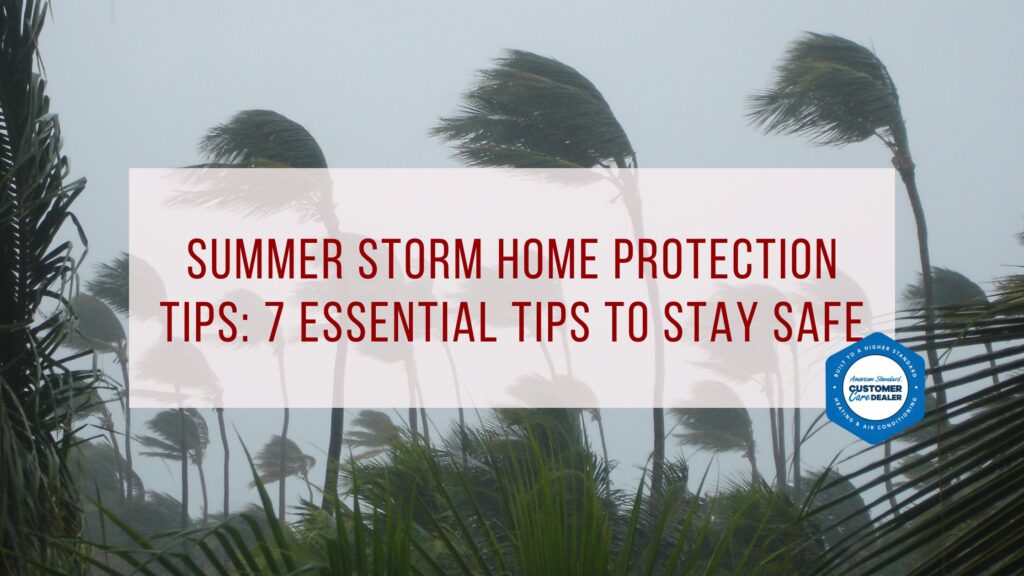Summer Storm Home Protection Tips
Summer storms can wreak havoc when you least expect it. From strong winds to flooding rains, these weather disturbances pose a serious threat to your home and property. While summer storm season can’t be avoided, you can fortify your home to minimize potential damage. Whether it’s preparing your roof or addressing drainage issues, staying proactive can protect your loved ones and save you money in repair costs.
By following these summer storm home protection strategies, you can better prepare and safeguard your property against unpredictable weather conditions.
Here are seven essential tips to shield your home from Mother Nature’s fury this summer.
1. Inspect and Maintain Your Roof
Your roof is your first line of defense against summer storms, so keeping it in peak condition is key. Regular inspections can help you catch loose shingles, damaged flashing, or any cracks that might allow water to seep in. Address small repairs immediately to prevent more significant issues, such as leaks or structural damage, during heavy rain or high winds.
If your roof is older, consider upgrading to more durable, storm-resistant materials like metal or asphalt shingles rated for high wind speeds. These options improve your home’s resilience while increasing its overall value.
Quick Tip: Look for signs of granule loss on shingles. This could indicate they’re nearing the end of their lifespan and may compromise your summer storm home protection efforts.
2. Trim Overhanging Trees
While trees offer shade and beauty to your yard, overhanging branches can become dangerous projectiles during a storm. Trim any branches near your house, especially those hanging over your roof, windows, or power lines.
Additionally, check trees for signs of rot or disease that could make them more likely to fall in high winds. A certified arborist can assess the health of your trees and recommend safe removal if necessary.
Pro Tip: Don’t DIY large tree removals. Always consult professionals to avoid accidents or property damage while improving your summer storm home protection plan.
3. Secure Windows, Doors, and Garage Doors
Wind and debris are major culprits when it comes to storm damage. Protect your windows and doors by installing storm shutters or applying shatter-resistant window film. Double-check weatherstripping around doors to ensure a snug seal that prevents water intrusion.
Your garage door is another critical weak point. Reinforce it with a bracing kit or upgrade to a wind-rated door if you live in an area prone to hurricanes or tornadoes. A strong garage door will protect both your vehicle and the home itself, enhancing your summer storm home protection features.
4. Clean Your Gutters and Downspouts
Clogged gutters are a recipe for disaster during heavy rainfall. Water can back up, overflow, and pool around your home’s foundation, leading to flooding or structural damage.
Make it a habit to clean your gutters and downspouts at least twice a year, or more frequently if you have overhanging trees. Ensure that downspouts direct water at least six feet away from your home to prevent seepage into your basement or crawl space. Proper gutter maintenance is an essential part of summer storm home protection.
5. Check Your Home’s Drainage System
Beyond gutters, an effective drainage system keeps your home safe from water damage. Inspect your yard for low-lying areas where water tends to collect and pool. These can often lead to foundation issues over time.
Consider having a professional install a French drain, sump pump, or swales to direct water away from vulnerable areas. Maintaining proper grading around your home is also critical. Ensure that the ground slopes away from your house by at least six inches over ten feet. Good drainage is one of the cornerstones of summer storm home protection.
6. Anchor Outdoor Items
High winds can turn outdoor furniture, grills, or even trampolines into dangerous missiles that damage your home or your neighbor’s property. Before a storm hits, secure loose items by anchoring them down or bringing them inside.
Don’t forget smaller items like potted plants, garden tools, or lawn decorations, as these can easily become hazardous during a storm. A little effort now can save you big headaches later and improve your summer storm home protection plan.
7. Prepare for Power Outages
Summer storms often come with power outages. Equip your home with a battery backup for essential systems, like your sump pump or freezer, to avoid complications during a blackout.
Additionally, keep a well-stocked emergency kit with flashlights, batteries, a portable charger, and first-aid supplies. If you experience frequent outages, consider investing in a whole-home generator to keep your family comfortable and safe.
Quick Tip: Always have an ample supply of drinking water and non-perishable food on hand. A reliable emergency kit is a key part of summer storm home protection.
Frequently Asked Questions
Q1. How do I know if my roof is storm-ready?
Regular roof inspections are the best way to determine its condition. Look for loose or missing shingles, cracked flashing, or signs of leaks. If you’re unsure, consult a professional roofing contractor for a detailed evaluation.
Q2. What should I do if I have a tree too close to my home?
An overhanging tree can pose serious risks during a storm. Trim its branches to minimize damage or consult a certified arborist to assess whether the tree needs removal. Never attempt large-scale pruning or removal on your own, as this can be dangerous without proper equipment or expertise.
Q3. What’s the most important step to prevent water damage in heavy rain?
The two most critical steps are maintaining clean gutters and ensuring proper yard drainage. If you notice areas around your home where water tends to pool, address them promptly with professional drainage solutions like French drains, grading adjustments, or sump pumps.
Q4. Are storm shutters worth the investment?
Yes! Storm shutters provide excellent protection for your windows, preventing costly damage from flying debris. They’re particularly useful in hurricane-prone areas where glass shattering is a common concern.
Q5. How can I protect my outdoor AC unit during a storm?
Secure your outdoor unit by covering it with a tarp to block debris without blocking airflow, and anchor it to a concrete pad. Turn off the AC during severe weather to minimize electrical risks, and inspect the unit after the storm for any signs of damage.
Q6. What kind of generator is best for my home?
For extended power outages, a whole-home generator is the best option, though more expensive upfront. Portable generators work well for short-term outages, offering a budget-friendly alternative. Consult an electrician to determine the best fit for your needs.
By following these summer storm home protection tips, you can weather the season with confidence and safeguard your most valuable investment—your home.
Contact Us for Expert HVAC Services
With over 40 years of trusted experience, Climatech of Professional Air is here to keep your HVAC systems running smoothly. Whether it’s routine maintenance or emergency repairs, we’ve got you covered.
📞 Call 850-968-2161
📧 Email [email protected]
🌐 Visit www.climatechproair.com
Follow us on Facebook and Instagram for tips and updates. Trust us to keep your home comfortable year-round!


